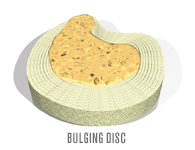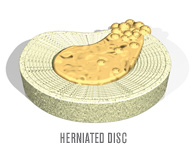What is Disc Herniation?
Healthy Disc
The discs of the spine receive nourishment through blood vessels until approximately the age of 20. At this point, the disc has been filled with a lifetime supply of nourishment. However, the disc has to make that supply of nourishment last a lifetime. Through aging and with normal wear and tear, we use the nourishment and all experience a slow degeneration of the discs of the spine. This is normal aging. The more “stress” you put on the disc, the more you use up the nourishment, weakening and deteriorating the disc, creating a problem. One of the amazing benefits of decompression is that it heightens the disc space, and is seen to return it to normal size and function.
Bulging Disc

The jelly-like substance is prone to injury and the most common situation causing problems is one that puts pressure on the disc. The pressure causes the jelly material inside the disc to “bulge” or “slip” out of place. As this occurs, the bulge itself puts pressure on other structures near the disc like the nerves. That’s how bulging discs cause pressure to build up on the nerve.
Herniated Disc

Herniated discs are also often referred to as ruptured discs. A disc can bulge without herniating. When the jelly- like nucleus pulposis is under pressure, it can bulge. But, when the pressure is excessive, it can herniated (rupture) through the outer band called the annulus fibrosis. As the “herniated” disc material spills out, a portion can press on a nerve, causing pain and accompanying radiation and weakness of the muscles involved.
The nerve can get “pinched” resulting in the condition of sciatica, radiating pain to the buttocks and/or lower extremity (leg and calf). Over 90% of herniated discs occur in the lowest two levels of the lumbar spine, between L4/L5 and L5/S1.
The sooner you take action, the sooner we may be able to help you. Contact Chiropractor in Herndon and get started today!
CONTACT US »

